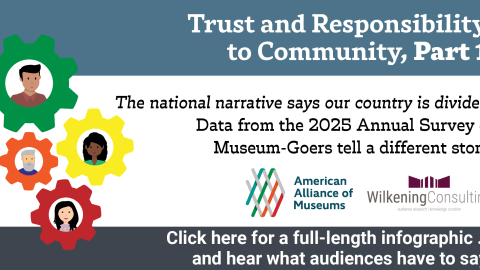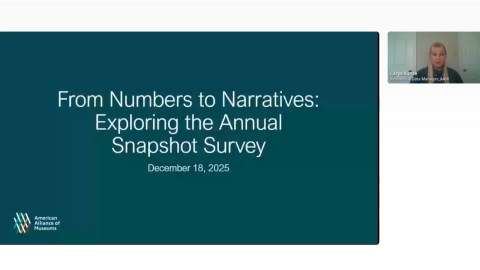Last week I joined Gregory Rodriguez, Lori Fogarty and Jim DeMersman on air for KQED’s Forum in San Francisco to discuss the effect of the recession on museums (archived recording here.) I was generally pleased with the discussion, but I am suffering from massive “Rats! I should have said…” syndrome regarding a question from one listener. Fortunately, this blog gives me an outlet for these second thoughts.
Michael’s email to the show blamed museums’ financial woes on the “anti-social management” of collections,pointing out that that “the Art Institute of Chicago could sell approximately 1% of its $35 billion collection and endow free admission forever.” I trotted out three answers, the first of which was the trite (but emotionally satisfying): “that’s like selling one of your children into servitude to support the others.”
Right after I finished the interview, I furiously scribbled down what I wish I had said:
1. Museums in the U.S. are filled with great collections largely because people donate them
2. If we start using collections as financial assets, the IRS is going to treat them as such, restricting or revoking the deductions associated with donations of collections (not to mention forcing museums to capitalize their collections and report them as assets, which would be a total pain in the ass.)
3. People who donate collections are motivated in large part by the associated tax-deduction
4. If the deduction disappeared, many of the donations would dry up
Then, being a good futurist-in-training, I sat back and started to question these assumptions. I think #1 holds up pretty well to examination. I am willing to say with complete confidence (despite the lack of data to back it up) that the vast majority of collections in our storage rooms were donated rather than purchased (and even the purchased objects are typically bought with charitable cash donations). Whether this is a good thing is another matter. I have long contended the prospect of “free” donations undermines attempts at rational collections planning by tempting museums to accept less than optimal material, using up scarce resources such as storage space, and staff time.
Having wrestled with IRS staff for many years on issues of capitalization, I am willing to stand by #2 as well. It has been extremely difficult to explain why our collections are primarily artistic, historic, cultural and scientific assets rather than financial assets. If we start conveniently treating them as financial assets whenever we need cash, that argument is going to quickly collapse. Particularly in light of pressure from pork-hunters such as Sen. Charles Grassley, R-Iowa, who takes particular delight in seeking for waste and fraud amongst nonprofits. Meanwhile, the financial downturn is pressuring the federal government to find additional tax revenues wherever it can. There is an ongoing struggle to diminish the deductibility of partial gifts of art—and I can easily envision a future in which there is no deductibility at all.
But starting with #3, I think my assertions begin to get shaky. Looking at the whole array of things donated to museums (archives, wedding dresses, doll collections, ethnographic artifacts from around the world, fossils, etc.), how strongly are donors influenced by the prospect of a tax deduction? Sure they may be tickled at the prospect (I like a 50-cent-off coupon as much as the next person) but for the vast majority of the middle class donating items of relatively modest value, will it really affect their bottom line? And (stand by, heresy alert here) unlike Michael, I am not just concerned about donations of multi-million-dollar major works of art. With objects that valuable, the owners are going to take damn good care of them—the older works have probably spent the majority of their existence in private hands already. As long as we know where they are, do they have to be in museum storage to be accessible, or can they be accessed via loans? (And if this isn’t a viable model, tell me why so many museums skip over the works in their collections to borrow from private collectors for many exhibitions…) I am more concerned about objects with relatively lower monetary value that may be lost, damaged or disassociated from crucial contextual data if they don’t find their way into nonprofit institutions that appreciate their (potential) significance.
This in turn leads me to question assumption #4. I don’t doubt there would be at least a temporary dip in contributions (as there was after the 1986 tax changes that lowered tax rates making deductions effectively smaller), as people hold on to their “precious” to see if the policy would (with rabid lobbying) reverse. But in the long run, will donors be primarily motivated by their desire to ensure their treasures are preserved for posterity, and shared with the world? I think the answer is yes.
That leads me to the second answer I gave on-air to Michael’s question—you can’t violate the public trust “just a little bit” and then expect people to be reassured that everything else in storage is safe. Either museums have the reputation of taking their public trust responsibilities seriously (demonstrating this with the huge angst and often field-wide hue and cry whenever collections are prominently deaccessioned) or they don’t. I do believe that if the collections in storage are treated as a rainy day fund, people will be less likely to take museums seriously as custodians of the nation’s (non-financial) assets.
And I stand by my third on-air answer to the question as well, which is that all other issues aside, selling collections is too easy a way to solve the problem. A fat endowment can be an invitation to continued irrelevance, if it leads you to ignore the need to make anyone else care about and support your institution. Isn’t it safer, and better, to be so important to so many people that they want to pay for your services (or pay to let others, perhaps with fewer financial resources than the donors, enjoy them as well)? Think about it…then post your responses here.









So.. (and I think I am agreeing with you here) if not motivated by $$, but instead about 'making a difference' or 'giving back' or 'making a legacy' or any of those emotional issues – would not those also be negatively impacted if the perception is that collections are for sale on convenience.
While the onus of inperpetuity would also run contrary to collections planning, that idea that this donated item will be here forever is, I think, very compelling to the donor.
If that is the case, what is the appropriate discussion to have with a donor, even assuming your institution has impeccable public trust and appropriate collections management policies, that there is always the possibility that the item might be deaccessioned?
I think the donation argument is a valid one, and has the obvious merit of a direct $$ effect, but I'm not sure it's the strongest reason simply because the deduction could disappear at some point in the future. My issue with selling off part of the collections is that it would be perceived by some museum managers as an "easy" solution compared with (for example) cutting staff or services. Setting aside damage to public trust, selling is not a sustainable strategy for the longer term given the rate at which collections grow.
It also raises the possibility that you might start to acquire objects with the intention of selling them at a later date – which makes you a business rather than a not-for-profit. It's easy to imagine a situation where potential resale value becomes one of the criteria for accessioning…
The issue of donor motivations is extremely complicated. A pretty good review of current thinking on the motivations for charitable giving is this recent report from the Center on Philanthropy at Indiana University, Understanding Donor Motivations for Giving: http://www.philanthropy.iupui.edu/Research/docs/2009CCS_FinalReport.pdf.
The report notes that "Although economists, psychologists, sociologists, and other researchers have identified many motivations for giving, including a variety of predictors, such as tax implications, altruism, and others, the models and theories of the motives for donating have proven insufficient … Motivations for giving are complex, often resulting from a mix of both intrinsic and extrinsic concerns" (p. 8).
This tends to support Elizabeth's argument that assumption #4 is wrong-headed, especially for richer donors, who are more likely to be motivated by abstract notions of the public good: "Higher income people (with an annual income of over $100,000) frame motivations for giving in terms of altruism and benefiting society at large" (p. 13). Note that this study did not distinguish between monetary and in-kind donations, such as artworks or other artifacts.
I think you too quickly gloss over the potential evils of indolence that can stem from a shiny new endowment gained from the sale of collections. I have seen it happen many times in nonprofits: you make a big one-time sale of some non-renewable asset with the intention that you only have to take such a drastic step once and then everything will be all better–and then boom! A year later you are looking around for one more big asset that you can pawn just this once…again!
I guess what I am saying is that the whole issue of selling collections is very reactionary. Reactionary is not strategic and what museums need to be is strategic in order to stay afloat and keep the doors open. Strategic deaccessioning in the name of collections planning rather than making $$ is a sensible way to look ahead to the future. The side benefit is that some overhead may be reduced as well (if, for example, you have to have extra off-site storage to house all the collections objects that don't really fit your mission).
I also wonder if this will be a sort of moot question in the future. As you so rightly (I think) point out, Elizabeth, if great works of art are still available through loans, why not keep them in the hands of the private collectors (and with those the collections, the cost of caring for them)? An example of how this is happening already the Broad Art Foundation.
And especially with the amazing advances in technology, I wonder if in the future museums will thoroughly document collections in the hands of private individuals for research purposes–not just photographing and cataloging them but generating 3D, microscopically detailed images and stuff like that–and occasionally borrow them for exhibits, but otherwise not bother actually collecting new objects per se, just their information…
Given the debate about selling collections objects, I was curious if anyone saw the article in the NYT about the LA County Museum of Art (http://www.nytimes.com/2010/01/08/arts/design/08vogel.html?ref=arts)? I'm also curious what everyone thinks of the article.
Looks like someone else has posed the same devil's advocate question, Elizabeth! http://www.nytimes.com/2010/01/02/opinion/02dobrzynski.html And here is the response from the President of the Getty: http://www.nytimes.com/2010/01/08/opinion/l08museum.html in which he reiterates my concern about stop-gap solutions, but he also raises new questions that I had not yet thought or nor heard addressed: how does the selling of collections affect the board and their perception of what their role/job is? Very interesting.
Wow what a great dialogue. Coming from museum settings where the objects are not generally 'works of art' nor high value in the marketplace, the issue unfolds somewhat differently. In the heritage arena, an institution may have six treadle sewing machines all donated by six families with local history. At some point the institution's collection policy has to address acquiring more, and also, as Allyson suggests, a strategic framework for deciding such questions as whether warehousing six such items is necessary to the organization's mission or even practical given limited collections resources. The donors' reasons for giving in these settings may often include a desire to preserve something that has personal meaning to them without having to dust it off in the front hall every few weeks. I know that smaller organizations also may accept such objects hoping that a matching cash gift may come with it.
Thanks, Elizabeth, for revisiting the subject at its broadest level for us.
Art Wolf posted a link to this article from the NY Times that talks about NY State trying to make deaccessioning collections for operating costs illegal. The real clincher is this statement:
“We have an incipient crisis,” Mr. Brodsky said at the round table, adding that he wanted “to make sure that we do not, in a crisis, see a massive privatization of art.”